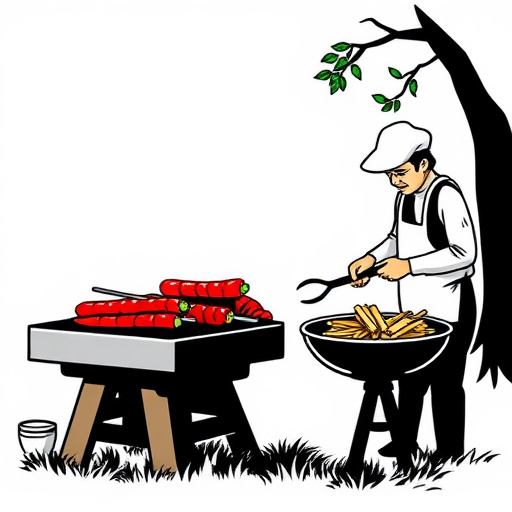Selecting the perfect rib cut (baby back or spare) is crucial for a mouthwatering BBQ ribs recipe, offering distinct flavors. High-quality, trimmed ribs ensure optimal cooking. Understanding St. Louis and Baby Back cuts enhances the experience. Using fresh herbs, local meat, and tangy barbecue sauce with marination for 2-3 hours or overnight creates tender, flavorful BBQ ribs, satisfying taste buds.
“Unleash the mouthwatering flavors of tender, slow-cooked BBQ ribs with this comprehensive guide to achieving perfection. From selecting the ideal St. Louis cut or baby back ribs to choosing the perfect tangy barbecue sauce, every step matters. Learn the art of marination and discover the best cooking techniques for a crispy exterior and melt-in-your-mouth meat. Explore creative serving suggestions, including sides and unique sauce variations, to transform your BBQ rib experience. Elevate your culinary skills with this ultimate BBQ ribs recipe.”
- Choosing the Right Ribs
- – Types of ribs: St. Louis cut vs. baby back
- – Selecting quality and freshness
- Marinating the Ribs
Choosing the Right Ribs

When it comes to achieving tender, mouthwatering BBQ ribs in your recipe, selecting the right cut is half the battle won. Look for rib cuts with plenty of meaty substance and minimal fat. The most common choice for a classic BBQ ribs recipe is baby back ribs or spare ribs. Both have their unique qualities: baby back ribs are often preferred for their tender texture and sweet flavor profile while spare ribs offer a hearty, rich taste due to their larger size and more bone structure.
Ensure your ribs are of good quality, with minimal signs of aging or tough connective tissues. Properly trimmed ribs will result in a better cooking experience and more satisfying final product. Remember, the right cut sets the stage for a delicious BBQ ribs recipe, allowing the flavors of your marinating sauce to penetrate and tenderize the meat evenly.
– Types of ribs: St. Louis cut vs. baby back

When it comes to BBQ ribs recipes, two popular cuts stand out: St. Louis-style and Baby Back. Each has its unique characteristics that cater to different tastes and cooking preferences. St. Louis ribs, also known as “cut in between” or “spare ribs,” are larger with a significant amount of meat attached to the bone. They have a meaty, robust flavor and are often favored for slow-smoking methods due to their sturdy nature. On the other hand, Baby Back ribs are smaller and come from the shorter end of the rib rack. These ribs are known for their tender, succulent meat and mild flavor profile, making them versatile for various cooking techniques, including grilling and slow roasting.
For BBQ rib lovers, understanding these cuts is essential when preparing mouthwatering dishes. St. Louis-style ribs pair well with hearty, tangy barbecue sauces, while Baby Back ribs can be enjoyed with a lighter, sweeter glaze, offering a delightful contrast in flavors. Whether you’re a fan of the meaty St. Louis cut or prefer the more delicate Baby Back, there’s a perfect rib recipe out there for every BBQ enthusiast to indulge in.
– Selecting quality and freshness

When it comes to crafting the perfect BBQ ribs recipe, selecting quality and fresh ingredients is paramount. Start with meaty, marbled ribs that are at least 1/2 inch thick for optimal flavor and tenderness. Choose a vibrant, tangy barbecue sauce that complements the ribs’ natural juices, ensuring every bite is a burst of savory goodness. Fresh herbs like thyme and rosemary can add an aromatic touch, enhancing the overall dining experience.
Freshness is key to achieving a truly exceptional BBQ ribs recipe. Opt for locally sourced meat if possible, ensuring it’s been properly aged to tenderize the fibers. Fresh vegetables for slaw or sides will also elevate the dish, providing a balance of textures and flavors that make this classic American comfort food so irresistible.
Marinating the Ribs

Marinating the ribs is a key step in developing their flavor profile for this mouthwatering BBQ ribs recipe. The process involves submerging the meat in a flavorful liquid for an extended period, allowing the sauce to penetrate and tenderize the fibers. In this case, a tangy barbecue sauce blend of tomatoes, vinegar, spices, and sugar is used to not only add depth but also help break down the collagen, resulting in incredibly tender ribs.
For best results, allow the ribs to marinate for at least 2-3 hours or even overnight in the refrigerator. This allows for maximum absorption of the sauce’s flavors. During this time, the acid in the vinegar helps to soften the meat while the spices and sugar contribute to a complex, balanced taste that will leave your taste buds craving more.
